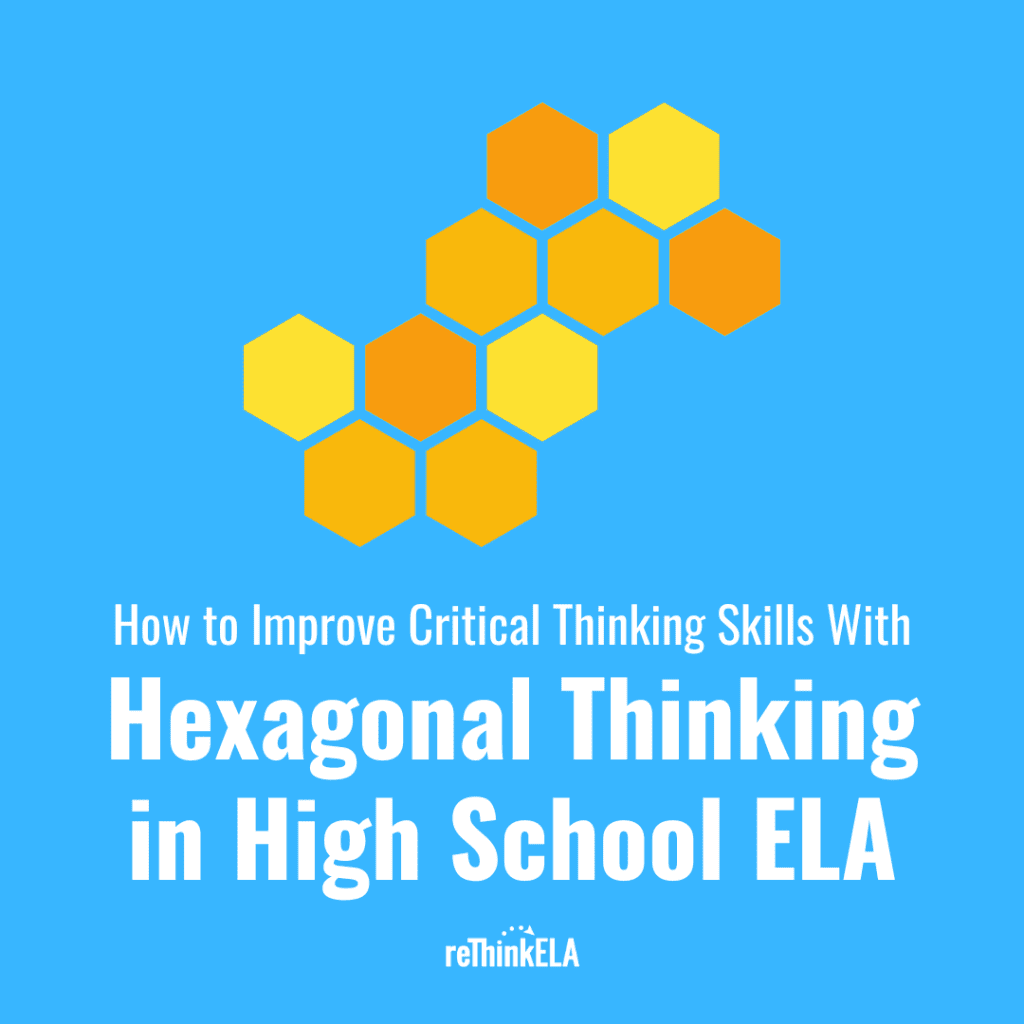
Critical thinking is a cornerstone of education, and nowhere is this more applicable than in the realm of English Language Arts (ELA). In high school ELA, it's about dissecting texts, comprehending their meanings, and connecting them to broader contexts both academically and within students’ personal lives. So how do we cultivate this vital skill most effectively? Enter hexagonal thinking. Hexagonal thinking in high school ELA provides an innovative and interactive approach to foster critical thinking, helping students to analyze, evaluate, and synthesize information in a manner that leads to a deep understanding and a reasoned approach to problem-solving (Potash, 2022).
Why is Critical Thinking Important in High School ELA
In ELA, critical thinking skills serve as the bedrock for reading comprehension, analytical writing, and oral communication (Gainer, 2012). They equip students with the ability to discern themes, interpret symbols, identify arguments, and evaluate the efficacy of rhetorical devices. They're crucial for students to navigate our increasingly complex and information-dense world.
The Role of Hexagonal Thinking
Hexagonal thinking is an effective instructional strategy to foster these critical thinking skills that Jennifer Gonzalez wrote about at Cult of Pedagogy a few years ago. It encourages learners to make connections, identify patterns, and develop a deeper understanding of the subject matter. And that's precisely what we'll be exploring next.
How to Improve Critical Thinking Skills with Hexagonal Thinking in High School ELA

My colleagues and I at the University of Oklahoma tested this strategy as part of a project I helped present in a doctoral level course.
The Concept of Hexagonal Thinking
Hexagonal thinking is a visual tool that helps students make connections between ideas, concepts, or textual elements (Fintelman, 2016). It involves writing ideas on hexagonal cards and arranging them so that the connected sides of the hexagons represent related ideas. But how does this play into ELA, you ask? Let's delve in.
Applying Hexagonal Thinking in ELA
Imagine a student reading a complex piece of literature, like The Book Thief or Killers of the Flower Moon (the movie has an anticipated release date in October 2023). They could write characters, themes, or events on the hexagonal cards. By linking these hexagons, they visually map the intricate web of relationships in the novel. This process requires critical thinking, as students must reason through the connections, discern patterns, and articulate their understanding.
Hexagonal Thinking and Critical Thinking: The Connection
Hexagonal thinking promotes critical thinking by pushing students beyond rote recall. They must comprehend the information deeply enough to see how it interrelates. This involves analyzing each piece of information, evaluating its importance, and synthesizing a cohesive understanding. Hence, hexagonal thinking offers a hands-on approach to boost critical thinking skills in high school ELA.
The Hexagonal Thinking Process: Step by Step

Understanding and applying hexagonal thinking may seem daunting at first glance, but it's as easy as pie once you get the hang of it. So, let's break it down step by step, and you'll be a hexagonal thinking whiz in no time!
Understanding Hexagonal Cards
Let's start with the basics - the hexagonal cards. These are simply hexagon-shaped pieces of paper, cardstock, or even digital elements that act as the tangible representations of ideas or concepts. Think of them as the building blocks of a giant puzzle that we're about to piece together.
Brianne Johnson, a doctoral student at the University of Oklahoma and English teacher at Bethel High School with a decade of experience in the classroom, wrote that she uses hexagonal thinking strategies in several ways. Johnson wrote:
I have used it as a discussion tool after we have read a novel, to track themes in a novel, to connect different texts to one another, to plan for an essay that asks students to synthesize information/evidence from multiple sources, to help develop a line of reasoning for an essay, etc.
Johnson made prepping for the activities significantly easier on herself by using a hexagon-shaped paper punch she found online. She added that it’s also important for teachers to start with fewer hexagons and build up to larger sets after students are more familiar with the strategy and to provide students with a framework that shows the connections between ideas, characters, themes, or other variables.
Each hexagon holds a single idea, character, theme, event, or quote from a text - anything that's integral to the study material. They're essentially bite-sized chunks of knowledge that students can handle, manipulate, and connect to form a broader, integrated understanding.
Johnson emphasized that the primary focus should be on the “process over pretty” (POP).
The emphasis for the activity has to be on learning and not a final product; the beauty and the meaning-making of the strategy are in the discussions that occur during the process. For hexagonal thinking to truly be beneficial in a classroom, teachers must be purposeful in the implementation and carefully design assessment to encourage students to explore ideas and connections.
Generating Ideas
Here's where the thinking cap comes into play! In this stage, students read through the text, identifying key elements that stand out. This could be a character's actions, a recurring theme, a plot twist, or a poignant quote - anything that strikes a chord or seems significant.
Students then jot down these ideas onto their hexagonal cards, one per card. They're encouraged to dig deep, interpret the text, and pull out as many relevant ideas as possible. It's a brainstorming session of sorts that stretches their comprehension and analytical skills.
Organizing Hexagonal Cards
Once the hexagonal cards are filled, it's time to dive into the heart of the hexagonal thinking process - organizing the cards. Students arrange their hexagons on a flat surface, creating a visual 'map' of their understanding.
This isn't a random process, though. They're required to connect related ideas side-by-side. So, two connected hexagons could represent a cause-and-effect relationship, a thematic link, or a character interaction, to name a few. The layout may change multiple times in this stage, and that's perfectly alright. After all, learning is a dynamic process!
Establishing Connections
Here's where the magic happens! As the students tinker with their hexagonal map, they start noticing patterns, connections, and insights they might have missed otherwise. This is the core of critical thinking - the ability to see the 'bigger picture' and how individual elements interrelate within it.
Students are encouraged to explain their connections out loud or write them down. This articulation pushes them to reason through their thoughts, honing their critical thinking skills further. It's not merely about laying out the hexagons; it's about justifying why they are laid out that way.
And voila, that's hexagonal thinking for you! With practice and persistence, this process can help students improve their critical thinking skills, making high school ELA a more engaging and rewarding experience.
The Impact of Hexagonal Thinking on High School ELA
Picture the difference between reading a book in isolation versus discussing it in a spirited book club. The latter undoubtedly enhances your understanding and enjoyment of the text, doesn't it? Similarly, hexagonal thinking can radically transform the high school ELA experience, making it more interactive, insightful, and downright fun. Let's delve into how.
Enhancing Reading Comprehension
We've all experienced those "aha!" moments while reading a great book, when seemingly disjointed plot points suddenly align into a coherent story. Hexagonal thinking offers a structured way, or scaffold, to help students to reach these moments of clarity.
Stern, Duncan, and Aleo remind us in Learning that Transfers of American psychologist Jerome Bruner's explanation for why structure is so important in cognitive learning theory:
Grasping the structure of a subject is understanding it in a way that permits many other things to be related to it meaningfully.
As students create and connect their hexagonal cards, they gain a tangible grasp of the text. They're no longer passive readers but active participants in the narrative, unraveling its layers and intricacies. The result? An enhanced understanding and appreciation of the text. Reading comprehension thus gets a solid boost, courtesy of hexagonal thinking.
Fostering In-depth Analysis
Hexagonal thinking isn't just about understanding what's on the page; it's about discovering what lies beneath. As students connect their hexagons, they can start to delve beneath the surface, exploring how and why elements within the text interact.
This demands an analytical mindset, which some students are still developing. This activity gives them a concrete way to practice the abstract skill of sifting through details, discern patterns, and drawing insightful conclusions. Such in-depth analysis is at the heart of ELA and critical thinking, and hexagonal thinking provides a robust framework to foster it.
Improving Writing Skills
You might be wondering, "What does hexagonal thinking have to do with writing skills?" Quite a bit, as it turns out. As students articulate their hexagonal connections, either verbally or in writing, they're practicing their communication skills.
It's also important to note that the process of distilling complex ideas into succinct hexagonal cards sharpens their ability to convey information concisely and effectively. The skills honed through hexagonal thinking—critical thinking, analysis, articulation—are all crucial for effective writing, making it a powerful tool to improve writing skills in high school ELA.
In other words: hexagonal thinking isn't just a novel teaching strategy. It's meat-and-potatoes teaching, a catalyst for learning, a tool that empowers students to unravel the complexities of ELA, improving their reading comprehension, analytical skills, and writing prowess along the way. Sounds like a win-win, doesn't it?
Incorporating Hexagonal Thinking in the ELA Curriculum
You've got the why and the how of hexagonal thinking down pat. Now, it's time to bring it to life in the ELA classroom. But how do you integrate this approach seamlessly into the curriculum? Don't fret, I've got you covered!
Introducing Hexagonal Thinking to Your Students
As with any new concept, the first step is to introduce hexagonal thinking to the students. Begin with a simple, non-academic example to illustrate the concept to the whole class. Think concrete concepts, not abstract.
For instance, if you have significant population of mechanically inclined students, use hexagonal cards to represent different parts of a car (engine, wheels, steering, brakes, and so forth). Connect these hexagons to show how each part contributes to the car's overall function. This tangible demonstration will help students grasp the concept and see its potential.
Next, transition into an ELA context. Perhaps start with a familiar short story or a poem, breaking down its elements into hexagonal cards and discussing how they connect. Remember, the key here is to provide a supportive, explorative environment where students can grasp and appreciate this new learning strategy. You might also consider making this transition as a whole class, or letting students work together in groups, depending on how well they're grasping the concept at this stage. Think in terms of a gradual release of responsibility.
Incorporating Hexagonal Thinking in Lesson Plans
Once the students are comfortable with hexagonal thinking, it's time to incorporate it into your ELA lesson plans. Here's a potential roadmap:
The beauty of hexagonal thinking is its flexibility. You can adapt it to suit various texts, themes, and classroom dynamics. So, feel free to experiment and discover what works best for your students.
Assessing Students’ Progress
Assessment is a crucial part of any teaching strategy, and hexagonal thinking is no exception. But here's the catch: traditional tests might not capture the depth of learning that hexagonal thinking fosters. So, consider alternative assessment methods such as:
By integrating hexagonal thinking into your ELA curriculum, you're not just teaching students about literature. You're equipping them with a powerful tool to make sense of complex information, fostering critical thinkers who can navigate the world with insight and confidence.
Johnson noted that some of her favorite days to teach are those that included hexagonal thinking activities.
While the teacher is still a coach in the classroom, there is also opportunity for the students to shift into the role of a coach and the teacher is able to shift into the role of a student. Our students take the lead and share ideas—we are no longer the sage on the stage, but the guide on the side.
Frequently Asked Questions on Hexagonal Thinking in High School ELA
Hexagonal thinking is a visual tool that aids in understanding complex, interconnected topics. It involves writing down individual ideas or elements onto hexagon-shaped cards and then linking related concepts together. This process encourages students to explore and articulate the connections between various ideas, fostering critical thinking skills.
Hexagonal thinking encourages students to delve deep into a text and explore how its various elements interrelate. This not only enhances reading comprehension but also fosters critical thinking and in-depth analysis. Moreover, by articulating these connections, students also improve their communication and writing skills.
Hexagonal thinking can be introduced at various stages of a lesson plan. For instance, you could use it as a pre-reading strategy to prime students on key concepts, as a during-reading tool to improve engagement and retention, and as a post-reading activity to consolidate learning and foster critical thinking.
Absolutely! The beauty of hexagonal thinking is its adaptability. It can be tailored to suit various learning styles and levels. For instance, for students who struggle with abstraction, you can begin with very concrete hexagons and gradually introduce more complex ones.
Traditional tests may not adequately capture the depth of learning with hexagonal thinking. Consider alternative assessment methods such as reviewing students' hexagonal maps and asking for reflection papers on their hexagonal thinking process.
Like any teaching strategy, hexagonal thinking may have its challenges. It requires careful guidance and support, especially during the initial stages. However, with patience and practice, it can become a powerful tool to foster critical thinking skills in students. Remember, the key is to experiment and adapt, finding out what works best for your students.
Empowering High School ELA with Hexagonal Thinking
As we approach the end of this comprehensive guide, it's time to step back and appreciate the bigger picture. What is the ultimate goal of all these hexagons, connections, and critical thinking? It's about empowering students to navigate not just ELA, but the world at large, with insight, confidence, and a love for learning.
Hexagonal thinking is a powerful teaching strategy that encourages students to delve deep into a text, unravel its complexities, and discover its hidden intricacies. From enhancing reading comprehension to fostering in-depth analysis, hexagonal thinking has a lot to offer for High School ELA.
By breaking down complex concepts into digestible hexagonal cards, students can tangibly grasp and explore various elements within a text. As they connect these hexagons, they're propelled to think critically and analytically, deciphering the "why" and "how" behind the text's interwoven elements.
Moreover, hexagonal thinking is not just about reading or thinking—it's about communicating too. As students articulate their hexagonal connections, they're honing their communication and writing skills. So, all in all, hexagonal thinking offers a well-rounded approach to improve various facets of high school ELA.
The Way Forward with Hexagonal Thinking in ELA
So, where do we go from here? The possibilities are limited only by your imagination (and tolerance for cutting out hexagons). Hexagonal thinking offers a flexible, adaptable framework that can be tailored to suit various texts, themes, and classroom dynamics.
Perhaps you could experiment with different genres, time periods, or cultural contexts. Or, consider sharing your hexagonal thinking strategies with your colleagues so they can integrate it into other aspects of the curriculum, such as social studies or science. The key is to keep exploring, innovating, and, most importantly, enjoying the learning process.
References
- Fintelman, E. (2016, October 6). Hexagonal thinking. Mrs Fintelman Teaches.
- Gainer, J. (2012). Critical thinking: Foundational for digital literacies and democracy. Journal of adolescent & adult literacy, 56(1), 14-17.
- Potash, B. (2022, March 1). Hexagonal thinking: A colorful tool for discussion. Cult of Pedagogy.
- Stern, J., Ferraro, K., Duncan, K., & Aleo, T. (2021). Learning that transfers: Designing curriculum for a changing world. Corwin Press.

